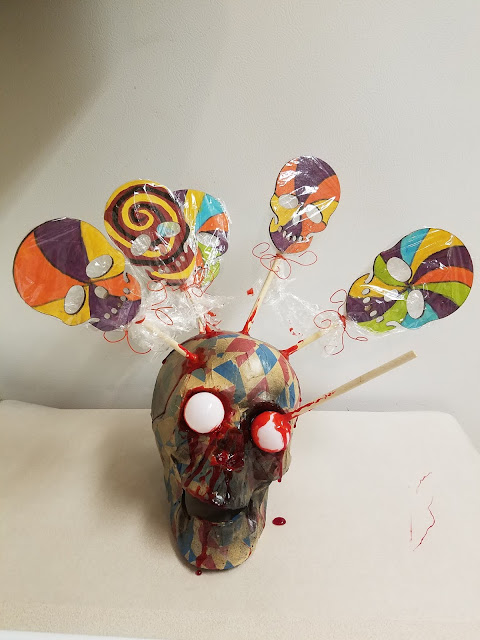$30 - $40 (based on 2017 prices)
Makes one bassinet
2017’s haunt explored the legend of La Llorona. To expand upon the element of prolicide prevalent in the folklore, I drew inspiration from La Isla de las Muñecas and filled the haunt with dolls to represent the specter’s drowned children. This particular prop was the crowning feature of the doll-filled room and rested center stage among its bevy of creepy peers. Although I repurposed an old basket and skeleton puppet, the same effect can be achieved with a newer doll and actual bassinet modified for the display.
- One twelve-inch doll with vinyl limbs and head
- One 8 oz. can of oil-based interior wood stain in red chestnut*
- One large wicker basket with handle (roughly 3’ long and 1.5’ wide)
- One 10 oz. can of interior/exterior, fast-drying spray paint in nutmeg*
- One 10 oz. can of interior/exterior, fast-drying spray paint in flat black*
- Twelve random vinyl doll pieces (ten hands, one foot, and one face)
- Three small plastic mandibles
- One 2 oz. bottle of acrylic paint in flat beige*
- One 2 oz. bottle of acrylic paint in flat black*
- One 2 oz. bottle of acrylic paint in flat brown*
- One 2 oz. bottle of acrylic paint in flat gray*
- One 2 oz. bottle of acrylic paint in flat tan*
- One 2 oz. bottle of acrylic paint in flat white*
- One 4 oz. bottle of all-purpose tacky glue*
- One 4 oz. bottle of wood glue*
- Four to five yards of light brown twine
- One yard of black lace
1. Remove all of the doll’s clothes and, on a newspaper-lined surface in a well-ventilated area, stain the head and limbs. I began by giving each one a light, even coat with a foam brush. After that, I applied heavy amounts of stain to the ends and patted away the excess with paper towels. You want the color to build up in the cracks and fissures. Although you may use whatever color of stain you desire, I chose red chestnut because it gives the pieces a fresh, meaty appearance. Once you have achieved your intended look, allow the parts to dry. I let mine sit outside in the sun for three days.
2. On a newspaper-lined surface in a well-ventilated area, dust the basket with a light coat of black and brown spray paint to add age and distress. To give the appearance of dirt, hold the can over twelve inches away from the basket’s surface and make quick flicking motions. You can also apply a flecking of black paint and smears of brown paint to enhance the weathered appearance.

3. On a newspaper-lined surface in a well-ventilated area, crackle paint the doll hands and foot. To do this, begin with a base coat of black paint and, once that has dried, use a thick brush to smear a smattering of wood glue onto the prop. Try not to over think your application (a random pattern produces the best results). Let the glue sit for a minute to become tacky and then cover the appendages with a coat of beige paint. As the glue and paint dry, they will form cracks. To further the aging process, give the items a light smudging of brown paint to simulate dirt. Once all the paint has dried, cut twine into twelve-inch sections and wrap one end around the hands and leg.
4. Attach the limbs to the basket by wrapping the free end of the twine around the rim, tying the strands, trimming the excess, and gluing the knots for reinforcement. For visual interest, stagger the length of the strings and do not evenly space these items. This will provide a haphazard design that only enhances the creepiness.
5. On a newspaper-lined surface in a well-ventilated area, give the doll face three even coats of gray paint. The number of coats, of course, depends on your desired coverage, so you may apply more or less. Once the paint is dry, use a brush with splayed bristles to create a stippling effect around the face’s edges and opening. I found that working from dark to light (i.e. black to gray to white) produces the best results. After the paint dries, attach it to the front of the basket by wrapping twine around the rim and through the eye sockets, tying the strands, trimming the excess, and gluing the knots for reinforcement.

6. On a newspaper-lined surface in a well-ventilated area, evenly paint the mandibles tan. Although I used three coats, you may want more based on your chosen appearance. Following this, detail the bones by building up layers of smudged black along the edges of fissures. After the paint has dried, bind them together with strands of twine and tie them to the handle to form a mobile.
7. Wrap the doll in a blanket and glue its top toward the rim of the basket to create a downward angle that makes the doll look like it is reclining (you could also build up layers of padding below the doll to achieve this effect). To enhance the prop’s appearance, consider distressing the blanket with dustings of black and brown spray paint, smudges of paint, and shreds in the fabric.
8. Stretch the lace across the space between the handle and the basket and glue it in place to fabricate a hood for the bassinet. You could do this with only one side (as I did) or both. Keep in mind, though, that, if you do cover both sides, you will want a fabric thin enough or with enough openings to make the doll visible.
9. You can enhance the prop further with additional flourishes, including clusters of bugs, a mangled teddy bear, or a blood-filled bottle.
*You will not use the entire bottle’s content for this project.























